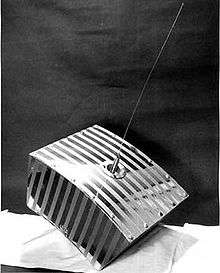OSCAR 2
OSCAR II (a.k.a. OSCAR 2) is the second amateur radio satellite launched by Project OSCAR into Low Earth orbit. OSCAR II was launched June 2, 1962, by a Thor-DM21 Agena B launcher from Vandenberg Air Force Base, Lompoc, California. The satellite, a rectangular box (30 cm × 25 cm × 12 cm (11.8 in × 9.8 in × 4.7 in)) weighing 10 kg (22 lb), was launched as a secondary payload (ballast) for Corona 43, the fifth launch of a KH-4 satellite.
 OSCAR 2 | |
| Mission type | Communications |
|---|---|
| Operator | Project OSCAR / DoD |
| Harvard designation | 1962 Chi 1 |
| COSPAR ID | 1962-022B |
| SATCAT no. | 305 |
| Mission duration | 22 days |
| Spacecraft properties | |
| Launch mass | 10.0 kilograms (22.0 lb) |
| Dimensions | 15.2 by 25.4 by 33 centimeters (6.0 in × 10.0 in × 13.0 in) |
| Start of mission | |
| Launch date | 2 June 1962, 00:43 UTC |
| Rocket | Thor DM-21 Agena-B |
| Launch site | Vandenberg LC-75-3-4 |
| End of mission | |
| Decay date | 21 June 1962 |
| Orbital parameters | |
| Reference system | Geocentric |
| Regime | Low Earth |
| Eccentricity | 0.01399 |
| Perigee altitude | 207 kilometers (129 mi) |
| Apogee altitude | 394 kilometers (245 mi) |
| Inclination | 101.00 degrees |
| Period | 90.5 minutes |
The satellite employed a monopole transmitting antenna 60 cm (24 in) long extended from the center of the convex surface, but had no attitude control system. OSCAR II lasted 18 days, ceasing operation on June 20, 1962, and re-entered June 21, 1962.[1][2]
OSCAR 2 incorporated certain design changes from the earlier OSCAR 1.[2]
- Changed the surface thermal coatings to achieve a cooler internal spacecraft environment.
- Modified the sensing system so the satellite temperature could be measured accurately as the batteries decayed.
- Lowered the transmitter power output to 100 mW to extend the life of the onboard battery.
Project OSCAR
Project OSCAR Inc. started in 1960 with the radio amateurs from the TRW Radio Club of Redondo Beach, California, many of whom worked at TRW and defense industries, to investigate the possibility of putting an amateur satellite in orbit. OSCAR stands for Orbiting Satellite Carrying Amateur Radio. Project OSCAR was responsible for the construction of the first amateur radio satellite, OSCAR-1, successfully launched from Vandenberg AFB in California. OSCAR-1 orbited the earth for 22 days, transmitting the "HI" greeting in Morse code (four dots, then two dots .... ..). Project Oscar was responsible for launching three other amateur radio satellites during the 1960s: OSCAR 1, OSCAR 3, and OSCAR 4.
In 1969, AMSAT-NA was founded by radio amateurs working at NASA's Goddard Space Flight Center and the Baltimore-Washington DC region, to continue the efforts begun by Project OSCAR. Its first project was to coordinate the launch of Australis-OSCAR 5, constructed by students at the University of Melbourne.[3]
Over fifty years later, Project OSCAR's mission is "To initiate and support activities that promote the Satellite Amateur Radio Hobby". Its primary goal is to reach out and provide logistical support, training and in some cases equipment to amateur radio associations, schools and the public at large.
References
- "Oscar 2". NASA National Space Science Data Center. 30 June 1977. Retrieved 14 February 2013.
- "OSCAR 2". Gunter's Space Page. 31 December 1999. Retrieved 14 February 2013.
- "Space Satellites from the World's Garage – The Story of AMSAT". AMSAT-NA. Archived from the original on 5 October 2006. Retrieved 14 February 2013.
![]()
